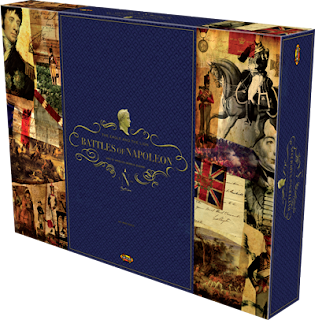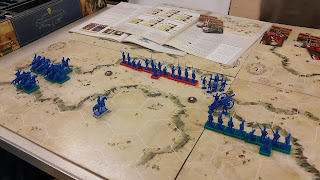Robert Dunlop, a major contributor to Great War Spearhead, kindly introduced me to the rules. Rather than play on opposing sides we went through the sequence and mechanics of play together. This is an absolutely brilliant approach to teaching rules and makes me wonder why I've never tried the same thing myself!
GWSH evolved from Arty Conliffe's original WW2 Spearhead and was developed by Shawn Taylor with Robert's support. The current edition (GWSH II) is now a fully standalone set of rules. Different rules model different things. The Spearhead family focuses on orders which are marked on maps by arrows of advance. These become the absolute drivers of the game until the enemy are spotted and the play becomes tactical. For that the mechanics are relatively simple.
This approach forces the players to plan. They must study the terrain, look at the routes of advance, and consider the areas of deployment. Crucially, they must also take into account likely or possible enemy plans. Later in the game they may discover the holes and be forced to alter plans and move formations.
GWSH uses a scale of about 80 yards to 1 inch. The 30mm square bases used in the game represent companies and about 12-16 of these are grouped into regiments (British brigades) which are the principal level for order writing and manoeuvre. Four regiments might form a division and two divisions a corps. I generalise here in order to give an idea of scale. A divisional game is a reasonable size for an evening's entertainment, but much larger games can and have been staged.
I now look forward to playing a proper game. Spearhead's grand tactical nature does, of course, appeal to me. In fact, my 10mm Normandy armies were planned and organised for playing the original WW2 version, although I've never got round to using them.
Great War Spearhead
Wednesday 29 March 2017
Thursday 23 March 2017
Great War Crossfire
Robert has recently been quoting chapter and verse on the Yahoo Crossfire group about low level training and actions during WW1 - the level that Crossfire represents - so I was keen to see how a WW1 game would work with these WW2 rules.
The game was a meeting battle, a common occurrence in northern France in the early days of WW1 during the Race to the Sea. Robert posted an eloquent account of the game in the Crossfire Yahoo Group placing it in historical context.
The absence of smoke and the relative scarcity of HMGs made this a significantly different style of game to the WW2 ones I've played but the rules worked equally well.
 |
| Plenty of reserves but nowhere to send them except into the German meat-grinder. Miniatures are 15mm Peter Pig and Minifigs. |
Labels:
15mm,
Crossfire,
Great War Spearhead,
Minifigs,
Peter Pig,
Robert Dunlop,
WW1
Friday 17 March 2017
Battles of Napoleon
 Battles of Napoleon is a hex board game with miniatures which was published in 2010 and is no longer in print. Despite a superficial similarity in appearance to the Command & Colors series of games, it plays quite differently.
Battles of Napoleon is a hex board game with miniatures which was published in 2010 and is no longer in print. Despite a superficial similarity in appearance to the Command & Colors series of games, it plays quite differently.Board games with miniatures are said to be the wave of the future, and I would say that miniatures games with hexes or squares are effectively converging from the other direction. This was thus a game I was keen to try.
My friend Ian, who owns the game, chose the Salamanca scenario and gave me the French with the warning that I was unlikely to win, but fate decided otherwise. The British were stronger, particularly in cavalry, but I had more artillery and a good position on a ridge line defending the three objectives which start in French hands.
The aim of this scenario is to take a majority of the objectives, but you can also win the game by destroying a certain number of units or killing the enemy c-in-c.
 |
| The initial French deployment. The British are yet to set up. |
The British made a frontal assault in column and uphill which gave me two bonuses in firepower. Coupled with a run of skillful dice throwing (!), the British attack shattered on the French rock. The British may have suffered from bad luck but I believe they would have needed an equally exceptional run of good luck to have succeeded in their strategy.
 |
| The French hold firm while the British begin to suffer. |
I really enjoyed the game and I think Napoleonic buffs would prefer this game to the more abstract approach of C&C Napoleonics.
Labels:
19th Century,
Battles of Napoleon,
Boardgames,
Napoleonic
Friday 10 March 2017
Star Wars: X-Wing Miniatures Game
I don't have much time at the moment to sort out my own games so I'm grateful for the opportunity to play other people's games, even though these are not necessarily part of my annual plan! This recently included a couple of games of X-Wing, the highly popular Star Wars spaceship combat game.
The games were based on a simple introductory scenario which pitted a pair of TIE fighters against an upgraded X-Wing, the components of the core introductory set. I controlled one of the TIE fighters. Although they are generally more manoeuvrable, the upgraded X-Wing continually escaped our arcs of fire while bringing us into its own arc of fire and I was quickly eliminated in the first game.
In the second game it was my companion's turn to be knocked out first. I fared a little better but was still unable to inflict much damage. The X-Wing, however, accidentally flew off the table, giving me the game. It was a victory of sorts, but not really a satisfying one. Had the battlefield been a bit more crowded, we would more easily have ended up with some sort of target in our sights.
 The game mechanisms are similar to Wings of Glory WW1 (originally Wings of War) and the game plays straight out of the box. The rules are well written and the gameplay is smooth. The diminutive spaceships are very nicely modelled. I've seen the game played with much larger numbers of much larger ships, so it is very open to the escalation of financial investment.
The game mechanisms are similar to Wings of Glory WW1 (originally Wings of War) and the game plays straight out of the box. The rules are well written and the gameplay is smooth. The diminutive spaceships are very nicely modelled. I've seen the game played with much larger numbers of much larger ships, so it is very open to the escalation of financial investment.
Despite my recent foray into 15mm Sci-Fi skirmish gaming I'm not a Star Wars fan (or a Trekky), and spaceship combat doesn't really appeal to me. If I wanted to invest in a game of this sort I would probably go for the historical Wings of Glory. At one time I was quite interested in the WW2 variant, but my understanding is that it involves a lot of manoeuvre and that the chance actually to fire is rare, a somewhat frustrating recipe for a wargame. In any event I understand it's out of print at the moment, but never say never. And I see that Ares Games are due to release a new Battle of Britain Starter Set...
The games were based on a simple introductory scenario which pitted a pair of TIE fighters against an upgraded X-Wing, the components of the core introductory set. I controlled one of the TIE fighters. Although they are generally more manoeuvrable, the upgraded X-Wing continually escaped our arcs of fire while bringing us into its own arc of fire and I was quickly eliminated in the first game.
In the second game it was my companion's turn to be knocked out first. I fared a little better but was still unable to inflict much damage. The X-Wing, however, accidentally flew off the table, giving me the game. It was a victory of sorts, but not really a satisfying one. Had the battlefield been a bit more crowded, we would more easily have ended up with some sort of target in our sights.
 The game mechanisms are similar to Wings of Glory WW1 (originally Wings of War) and the game plays straight out of the box. The rules are well written and the gameplay is smooth. The diminutive spaceships are very nicely modelled. I've seen the game played with much larger numbers of much larger ships, so it is very open to the escalation of financial investment.
The game mechanisms are similar to Wings of Glory WW1 (originally Wings of War) and the game plays straight out of the box. The rules are well written and the gameplay is smooth. The diminutive spaceships are very nicely modelled. I've seen the game played with much larger numbers of much larger ships, so it is very open to the escalation of financial investment.Despite my recent foray into 15mm Sci-Fi skirmish gaming I'm not a Star Wars fan (or a Trekky), and spaceship combat doesn't really appeal to me. If I wanted to invest in a game of this sort I would probably go for the historical Wings of Glory. At one time I was quite interested in the WW2 variant, but my understanding is that it involves a lot of manoeuvre and that the chance actually to fire is rare, a somewhat frustrating recipe for a wargame. In any event I understand it's out of print at the moment, but never say never. And I see that Ares Games are due to release a new Battle of Britain Starter Set...
Subscribe to:
Posts (Atom)


